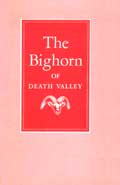.gif)
MENU
![]() Photographs
Photographs
|
Fauna of the National Parks — No. 6
The Bighorn of Death Valley |

|

Figure 1.—This old ewe was
the leader of the Badwater band. Her spreading horns, the right horn
notched and crimped, and other distinguishing features of her
companions, made possible the first uninterrupted month-long series of
daily dawn-to-dark observations of a recognizable band of bighorn. This
established the subsequent pattern of our research program.

Figure 2.—We also carried on
an extensive on-site interpretive program showing the bighorn to as many
as 150 carloads of visitors per day during the band's 3-months overall
use of the area.

Figure 3.—At the end of each
day we left the bighorn bedded down and moved whenever possible to
higher elevations to escape the heat. Here, at 5,000 feet in the
Cottonwood Mountains, the nights were comfortable for
sleeping.

Figure 4.—We returned to the
lower elevations during the hot days where the only shade was what we
made for ourselves.

Figure 5.—After 4 days, the
Badwater band climbed to a gravel- and water-filled basin, or tinaja,
where the animals drank. The wide horns of the three adults on the
right are a family characteristic. The uniquely down-curved horns of
Droopy, the adult to right of center, are unmistakable; the Old Leader
is left of center.

Figure 6.—Droopy reappeared
3 years later at Keystone Canyon 5 miles south of Badwater. Her unique
set of horns underscores the fact that "hornprints" are as valuable as
fingerprints in the identification of individuals. Each year of growth
adds a new segment at the base of the horn. Droopy is 8 years old here.

Figure 7.—The membership of
bighorn bands does not remain constant, nor are the animals so
gregarious that all are unhappy to be alone. For 38 days the Badwater
band remained unchanged. But later it diminished from six to four, then
one, as various individuals drifted away. The Old Leader seemed as
contented alone as when leading the band.
Continued >>>
 Top
Top
Last Modified: Thurs, May 16 2002 10:00:00 pm PDT
http://www.cr.nps.gov/history/online_books/fauna6/faunap.htm
![]()
